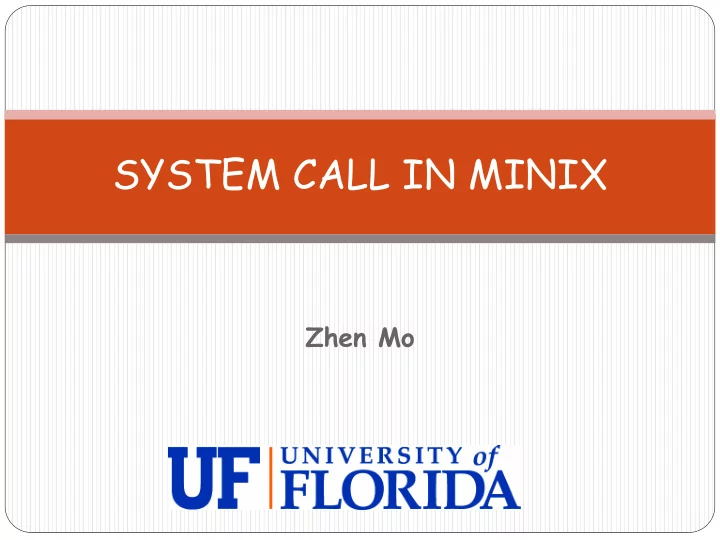

SYSTEM CALL IN MINIX Zhen Mo
What is the MINIX System? Mini Unix (Minix) basically, a UNIX compatible operating system. Open source : intend to be studied in universities Very small (kernel is under 4000 lines) Simple Design to be readable (thousands of comments) Written in C, with some very small parts in assembly language Minix is a microkernel-based operating system. 2
What is kernel? A program Central component of operating systems Manages the system's resources lowest-level abstraction layer for the resources (especially memory, processors and I/O devices) that application software must control to perform its functions. 3
What is microkernel? 4
What is the Minix 3 microkernel Architecture? 5
What is a System Call in Minix? A system call in Linux is how a program requests a service from the kernel. There are three types of calls in Minix: A system call in Minix is how a program requests a service from a server and/or a driver. A kernel call in Minix is how a server or driver requests a service from the kernel. Message/IPC/trap in Minix is used for interprocess communication. 6
Servers Reincarnation Server (RS): responsible for the reliability of the entire operating system Datastore Server (DS): DS provides a persistent storage of server state in memory. Virtual Memory server (VM): responsible for managing both virtual and physical memory mappings. Process Management server (PM):responsible for creating, destroying and managing processes in MINIX. 7
Servers Virtual File system Server (VFS): responsible for providing a unified interface to all mounted file systems in the system. Peripheral Component Interconnect Server (PCI): allows device drivers to access devices on the PCI bus. Internet Network Server (INET): responsible for the implementation of network protocols. 8
Drivers Terminal Driver (TTY) :TTY is responsible for the operation of the system console: Keyboard/Screen Serial: serial cable Pseudo: OpenSSH Disk Driver : The disk driver reads and writes disk blocks from and to the local disk(s) Memory Driver : The memory device driver is used during the bootstrapping of MINIX to serve as an initial le system. It contains configuration files and programs needed to startup MINIX Network Driver : MINIX supports various types of network cards. Each type of network card is implemented in a network device driver. 9
Inter Process Communication Is handled by the kernel A process sends a destination and a message to the kernel, which then copies the message to destination process A process must be waiting for the message in order to receive send receive sendrec (user processes are only allowed to use this one) 10
MINIX 3 source file organization usr/src/kernel – layer 4 (scheduling, messages and IO) usr/src/drivers – layer 3 (device drivers for disk, console, printer, other drivers) usr/src/servers – layer 2 (process manager, file system, other servers) usr/scr/lib – source code for library procedures (open, read, etc) usr/scr/include – all kinds of header files Each directory has its own Makefile 11
Learn MINIX source code Download the source code: https://github.com/minix3/minix Use code editor and code browser: Windows: source insight Linux: slickedit 12
Example - Kill main(): kill((pid_t) pid, (int) numsig) /bin/kill.c #define PM_PROC_NR ((endpoint_t) 0) #define VFS_PROC_NR ((endpoint_t) 1) #define RS_PROC_NR ((endpoint_t) 2) /include/minix/Com.h kill(): _syscall(PM_PROC_NR, KILL, message) / lib/libc/sys-minix/kill.c #define GETGROUPS 34 #define SYNC 36 #define KILL 37 /include/minix/Callnr.h _syscall(): sendrec(PM_PROC_NR, message) Type def struct message / lib/libc/sys-minix/Syscall.c /include/minix/ipc.h 13
Example - Kill do_kill 37 /usr/src/servers/pm/Table.c main(): (*call_vec[KILL])() int do_kill(void) /usr/src/servers/pm/main.c /usr/src/servers/pm/proto.h do_kill(): / check_sig(m_in.pid, m_in.sig_nr, FALSE) usr/src/servers/pm/signal.c sig_proc(): check_sig(): sys_kill(rmp->mp_endpoint, signo) sig_proc(rmp, signo, TRUE, ksig) / usr/src/servers/pm/signal.c / usr/src/servers/pm/signal.c 14
Example - Kill check_sig(): struct mproc *rmp; // process pointer to signal struct mproc *mp; // caller process pointer /* Check for permission. */ if (mp->mp_effuid != SUPER_USER && mp->mp_realuid != rmp->mp_realuid && mp->mp_effuid != rmp->mp_realuid && mp->mp_realuid != rmp->mp_effuid && mp->mp_effuid != rmp->mp_effuid) { error_code = EPERM; continue; } / usr/src/servers/pm/signal.c 15
Example - Kill EXTERN struct mproc { /* Real and effective uids and gids. */ uid_t mp_realuid; /* process' real uid */ uid_t mp_effuid; /* process' effective uid */ gid_t mp_realgid; /* process' real gid */ gid_t mp_effgid; /* process' effective gid */ /* Supplemental groups. */ int mp_ngroups; /* number of supplemental groups */ gid_t mp_sgroups[NGROUPS_MAX]; /* process' supplemental groups */ } / usr/src/servers/pm/mproc.c 16
Compile source code su cd /usr/src/releasetools make install reboot Press 2 Create a tar file in MINIX: tar -cf file.tar file1 file2 file3 17
Recommend
More recommend